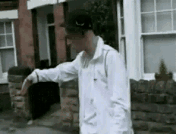

CANDIDATE NUMBER: 1316
Soft - Simon Ellis
Analysis

At the start of the movie, the film is shot from the point of view of, what we can assume to be, one of the youths on screen. The screen is in a different aspect ratio (Perhaps 4:9) and is very pixelated to simulate a cheap mobile phone camera. This connotes the youths' financial class and the audience can pick up this is the portrayal of common youth. The sound begins before the visual image is shown on screen which pushes the audience into the action s0 they can begin to speculate what events are transpiring.
The first scene is portrayed as a very generic bullying situation: There is the victim who is in school uniform to separate him from the others as well as the youth in the white tracksuit stands out from the rest og his group. This lets the audience know that the pinnacle of this conflict is between these two. The youth in the white tracksuit is shown as the main antagonist. The location is at the back of the park and is very secluded which, yet again, portrays a very generic bullying atmosphere.
After the bullying scene, it cuts to a shot of a middle class suburbia. The shot is still and the very generic sounds can be heard. This environment is meant to seem as average as possible so that the audience watching can relate closely and also wonder what is going to happen to disrupt this peaceful street. This is presented as a key location in the movie due to the amount of time that the shot lasts.
We now have a high angle shot that looks down the stairs. A boy's legs, who we can assume to be the man's son, makes his way to the top but then runs away. This was chosen by the director to show that the boy has something to hide. We later learn that, this is the case. The high angle shot represents the boy's relationship with his father as his attempts at calling his son appear futile as he gets no response. The loud boisterous music coming from the boy's room shows how he feels he can do what he likes. The audience feels the father's relief as the music fades upon entering the kitchen. It is later revealed that the boy's mother is not around often as he asks when she will be home. His parents are both clearly dedicated to their jobs.

The man goes out of the house for a very basic need: milk. This further supports how the director wants life to be as average as possible. - Who doesn't go out to get milk? - The shots cut between tracking the man walking down the street. Very calm sounds and smooth camera angles. At this point, the man is presented as the movie's main protagonist. His shots are juxtaposed by the phone camera shots of the youths loitering outside a local newsagents. As the shots become shorter, and the sound begins to merge, it becomes clear that the two parties will meet. This then becomes true.
The shop in which the man enters is dimly lit and very average. The fear and the way the actor of the man keeps looking at the door suggests that he is intimidated at this point. The audience would feel this too. We then follow the man back to his house in the reverse of his journey there and he has flashbacks of his encounter. We as an audience would then begin to feel the aggravation building within this man.
Back at home, the man moves to the kitchen. The camera is positioned at the very back of the kitchen and is at a close up shot with the father. This shows how the man wants to be as far away from the outside as possible as the window is still in shot. As the boy moves into the kitchen, his face is blurred and the left half is shadowed. This is the director telling the audience that he is hiding something, which we later learn is the injuries he received from the opening scene.
The gang of youths move to the outside and begin to create noise. They also create a perimeter around the man's car with the main white-clad youth on the bonnet. This can be compared to a pack of animals and how they make an area theirs. This is the director telling us that these youths have little moral, to the point where they are almost immoral. Like animals.
Scenes and shots become shorter and the sound becomes louder which heightens the chaotic atmosphere as the man decides what to do.
As soon as the man goes outside and the fight scene occurs, the camera is that off the mobile phone again. But, I noticed that as soon as the antagonist is attacked by the boy, the camera cuts back to 16:9 ratio. It is as if the camera represents the domineering atmosphere of the youth group and as soon as that cockiness is dealt with, order returns. The sound of the car alarm is stopped and the sound returns to how it was at the beginning of the film. Events end here so the audience can speculate the following steps in the father-son relationship. The shot then goes back to the first angled camera we saw in the street to show that everything has returned to how it was at the establishing shot of the movie.
